Unmasking the Dangers: The Hidden Health Risks of Wildfire Smoke
Science is only beginning to understand how smoke affects our health, but its secret may lie in the size of the particles it emits.
Wildfires are bigger, more severe and more common today in the western United States than at any time in the last four decades, with Maui, Hawaii’s devastating blaze being just the latest tragic example. In California, nearly half of the state’s largest fires on record occurred in the past three years.
We asked UC San Francisco professors of medicine Arianne Teherani, PhD, and Sheri Weiser, MD, why wildfire smoke is particularly bad for your health. Teherani and Weiser cofounded UCSF’s Center for Climate, Health and Equity as an education and research hub to shape climate action by ensuring health systems respond to the climate crisis.
Why have wildfires increased in California?
Climate change intensifies droughts, boosts strong winds, and increases lightning strikes, creating the perfect conditions for wildfires. Meanwhile, more people than ever live on the edges of wildlands that have changed to become more fire-prone. Grazing lands, for example, replaced harder-to-burn native landscapes. Drier conditions in California and a move away from historical, indigenous controlled-burn practices also means there are more dry plants and trees to burn in these spaces.
Can wildfire smoke make you sick?
Wildfire smoke enters the air as particle pollution, which is sometimes called “particulates” or “particulate matter.” Particulate matter is all around us, both indoors and outdoors, all the time, but wildfires emit massive amounts of particulate matter.
Wildfire smoke contains a mix of chemicals, including those released by homes as they burn – from household cleaners to asbestos siding. Depending on what’s fueling the fire, wildfire smoke can include things like sulfuric acid, dust and mold.
Why is particulate matter from wildfires so bad?
The bulk of wildfire smoke is made up of particulate matter that is about 30 times smaller than a human hair. This type of particulate matter poses the greatest risk to your health because it can work its way deep into your lungs and into your blood.
What are the health risks of inhaling wildfire smoke?
Wildfire smoke can make respiratory conditions like asthma and Chronic Obstructive Pulmonary Disease (COPD) worse and increase your risk of respiratory infections, such as bronchitis and pneumonia. Not surprisingly, wildfire smoke leads to more emergency room and doctor’s visits.
UCSF researchers are continuing to study wildfire smoke’s health effects. UCSF School of Medicine Associate Professor Jennifer Mulliken, MD and UCSF colleagues found that in California, large wildfires coincide with an 18% to 22% spike in invasive fungal infections like Valley Fever. Valley Fever, so called because it was first discovered in California’s San Joaquin Valley, can cause fatigue, body pains and shortness of breath. In some people, Valley Fever causes long-term lung damage.
What can I do to stay safe from wildfire smoke?
- Stay indoors and close your windows and doors
- Avoid heavy physical activity or being active for long periods of time.
- If you have an air conditioner, set it to recirculation mode and make sure to maintain its filter.
- Use portable air cleaners with HEPA filters.
- Consider using an N95 or K95 mask but be aware that even these masks can’t filter out certain gases released by wildfires. Wearing a mask doesn’t mean that you can work or play as normal outside. Remember that these masks are not suitable for very young children.
- If you have heart or lung disease, ask your health care provider if it is safe for you to wear a respirator.
Who is most at risk of falling ill from wildfire smoke?
- People with asthma and other respiratory diseases
- People with cardiovascular disease
- Children
- Pregnant people
- Older adults
- Outdoor workers
- Low-income communities and those of color
Can wildfire smoke disproportionately impact low-income communities and people of color?
Although most Americans in wildfire hazard zones are more socioeconomically secure, thousands of low-income communities are also on the frontlines for fire risk and lack the resources to prepare or recover from disasters. For example, some communities may not have the money to pay to insure their homes or belongings or replace them after a fire. Folks like this may already be at a higher risk for some chronic illnesses due to a lack of access to health care and poor working conditions, making them more vulnerable to smoke.
